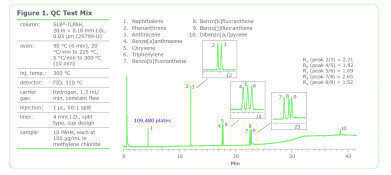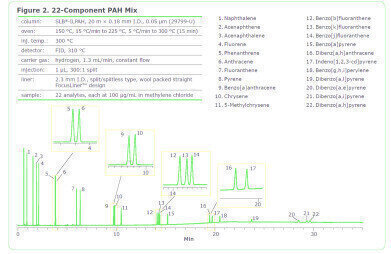-
 Figure 1 - QC Test Mix
Figure 1 - QC Test Mix -
 Figure 2 - 22-Component PAH Mix
Figure 2 - 22-Component PAH Mix
Environmental Laboratory
Achieve exceptional resolution of PAHs, including several isomer sets Using SLB®-ILPAH capillary GC columns
Feb 27 2020
Polycyclic aromatic hydrocarbons (PAHs) are ubiquitous in the environment and belong to the persistent organic pollutants (POPs). Monitoring is important because several of them are identified as carcinogens. Multiple isobaric isomers of PAHs exist, which are difficult to resolve chromatographically on conventional columns. The SLB®-ILPAH is a special purpose column for based on an ionic liquid stationary phase allowing an exceptional separation of PAHs, including several isomer sets. Complete column specifications are listed in Table 1.
Table 1. SLB®-ILPAH Column Specifications
Purpose - This special purpose and specially tested capillary GC column is designed for the analysis of polycyclic aromatic hydrocarbons (PAHs). Each column is individually tested to ensure resolution of several key sets (phenanthrene / anthracene, benzo[a]anthracene / chrysene / triphenylene, and benzo [b]fluoranthene / benzo[k]fluoranthene / benzo[j]fluoranthene).
Stationary Phase - 1,12-Di(tripropylphosphonium) dodecane, non-bonded
Temp. Limits - Subambient to 300°C (isothermal or programmed)
See Figure 1
Resolution Test
Every SLB-ILPAH column is tested to ensure it meets stringent resolution requirements for several sets of PAHs. Figure 1 depicts a chromatogram obtained from analysis of the QC test mix. All critical PAH isomers are baseline separated. The column efficiency is determined by measuring the theoretical plate value of naphthalene, in this case 109,480 plates have been obtained.
22-Component PAH Mix
PAHs need to be tested due to regulations of many authorities around the world ranging for sets of 16 to 24 PAHs. A 22-component PAH mixture of the most frequently listed PAHs was analyzed on a SLB®-ILPAH column (Figure 2). Beside of the separation of those isomers set, that was shown in the QC testing, this application demonstrates additionally the baseline separation of dibenz[a,h]anthracene (peak 16) and indeno[1,2,3-cd]perylene (peak 17), which cannot be achieved on conventional GC columns.
Conclusion
The main strength of ionic liquid GC columns is unique selectivity. For PAHs this ionic liquid column can achieve a level of separation not possible with conventional columns based on polysiloxane polymer or polyethylene glycol.
See Figure 2
For further information please click here.
Digital Edition
IET 34.2 March 2024
March 2024
Gas Detection - Biogas batch fermentation system for laboratory use with automatic gas analysis in real time Water/Wastewater - Upcycling sensors for sustainable nature management - Prist...
View all digital editions
Events
Apr 22 2024 Hannover, Germany
Apr 22 2024 Marrakech, Morroco
Apr 23 2024 Kuala Lumpur, Malaysia
Apr 23 2024 Kintex, South Korea
Apr 23 2024 Edmonton, AB, Canada

















